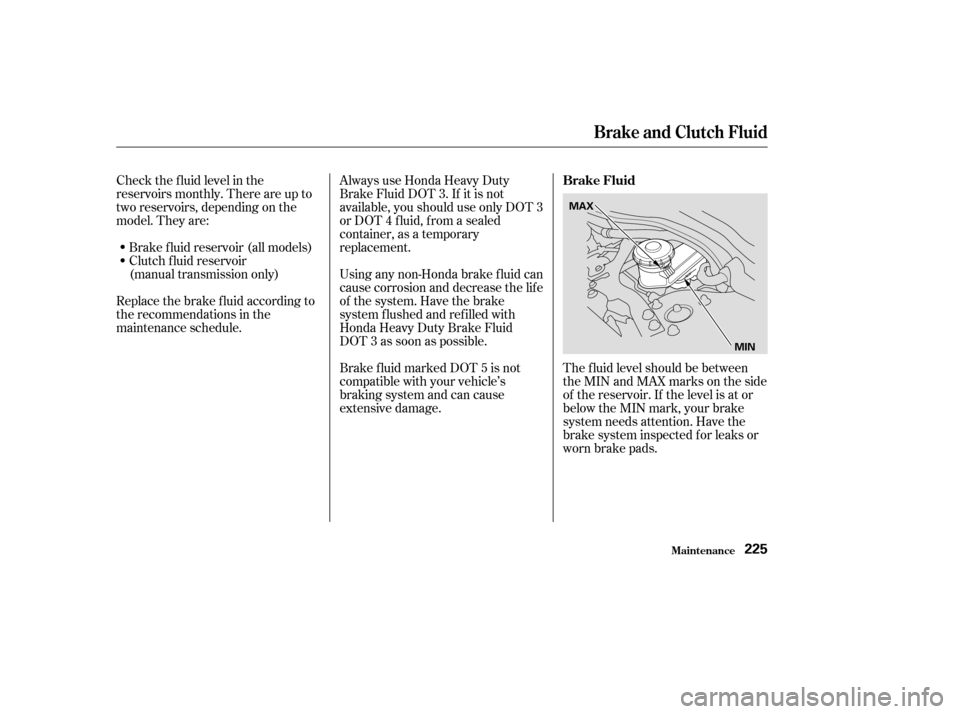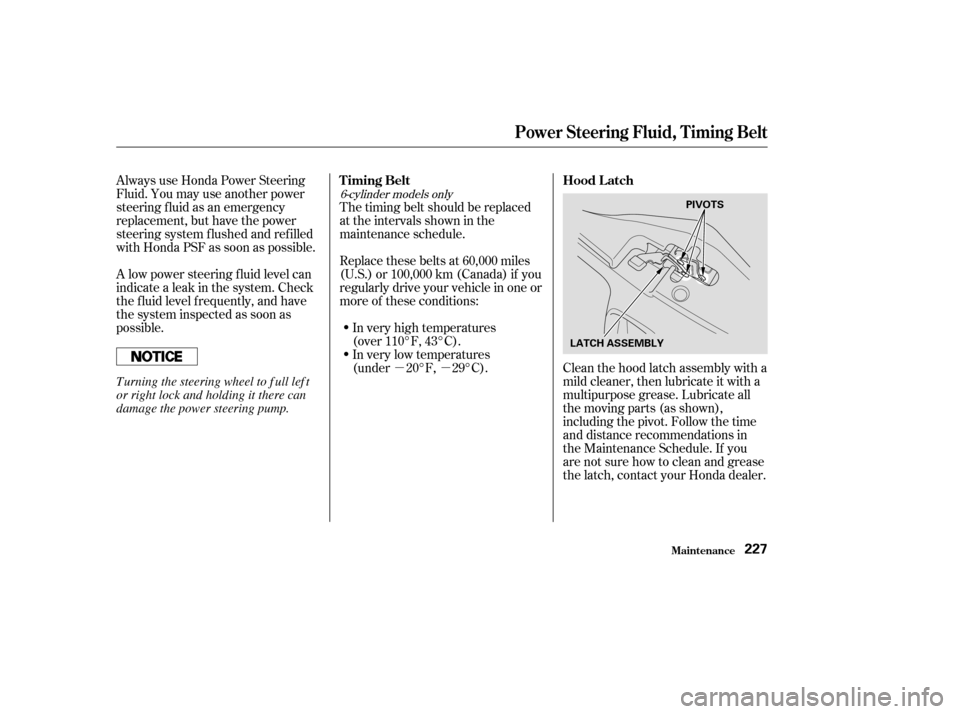Page 210 of 301
(f or Normal and Severe Schedules)Maintenance Record
Maint enance211
123,750 mi
125,000 mi
127,500 mi
130,000 mi
131,250 mi
135,000 mi
138,750 mi
140,000 mi142,500 mi
145,000 mi
146,250 mi
150,000 mi
198,000 km
200,000 km
204,000 km
208,000 km
210,000 km
216,000 km
222,000 km
224,000 km Signature or dealer stamp mi/km
Date
mi/kmDate
mi/kmDate
mi/kmDate
mi/kmDate
mi/kmDate
mi/kmDate
mi/kmDate228,000 km
232,000 km
234,000 km
240,000 km
Signature or dealer stamp mi/km
Date
mi/kmDate
mi/kmDate
mi/kmDate
�����—�����—�����y�
�������������y���
�(�������
���y�����
���y
Page 214 of 301

Honda Motor Oil is the pref erred
5W-20 lubricant f or your vehicle. It is
highly recommended that you use
Honda Motor Oil in your vehicle f or
optimum engine protection. Make
sure the API Certif ication Seal says
‘‘For Gasoline Engines’’.The oil viscosity or weight is
provided on the container’s label.
5W-20 oil is f ormulated f or year-
round protection of your Honda to
improve cold weather starting and
f uel economy.
You may use a synthetic motor oil if
it meets the same requirements
given f or a conventional motor oil: it
displays the API Certif ication Seal
and it is the proper weight. You must
f ollow the oil and f ilter change
intervals given on the maintenance
schedule.
Your Honda does not require any oil
additives. Additives may adversely
af f ect your engine’s or transmission’s
perf ormance and durability.
A dding Engine Oil
Maint enance
Synthetic Oil
Engine Oil A dditives
215
API CERTIFICATION SEAL
Ambient Temperature
�����—�����—�����y�
������
��
���y���
�(�������
���y�����
���y
Page 215 of 301

Remove the oil f ilter and let the
remaining oil drain. A special
wrench (available from your
Honda dealer) is required.
Open the hood and remove the
engine oil f ill cap. Remove the oil
drain bolt and washer f rom the
bottom of the engine. Drain the oil
into an appropriate container.
Always change the oil and f ilter
according to the recommendations in
the maintenance schedule. The oil
and f ilter collect contaminants that
can damage your engine if they are
not removed regularly.
Run the engine until it reaches
normal operating temperature,
then shut it off.
Changing the oil and f ilter requires
special tools and access f rom
underneath the vehicle. The vehicle
should be raised on a service station-
type hydraulic lif t f or this service.
Unless you have the knowledge and
proper equipment, you should have
this maintenance done by a skilled
mechanic.
3.
2.
1.
Changing the Oil and Filter
Maint enance216
WASHER
4-cylinder models WASHER
6-cylinder models
OIL DRAIN BOLT
OIL DRAIN BOLT
�����—�����—�����y�
������
������y���
�(�������
���y�����
���y
Page 221 of 301
To thoroughly f lush the transmission,
the technician should drain and ref ill
it with Honda ATF-Z1 (Automatic
Transmission Fluid), then drive the
vehicle f or a short distance. Do this
three times. Then drain and ref ill the
transmission a f inal time.Check the f luid level with the engine
at normal operating temperature.Park the vehicle on level ground.
Shut of f the engine.
Remove the dipstick (yellow loop)
f rom the transmission, and wipe it
with a clean cloth.
Insert the dipstick all the way back
into the transmission securely as
shown in the illustration.
The transmission should be drained
and ref illed with new f luid according
to the time and distance recommen-
dations in the maintenance schedule.
If you are not sure how to add f luid,
contact your Honda dealer.
1. 2.
6.
6-cylinder models
T ransmission Fluid
Maint enance
Automatic Transmission
222
DIPSTICK
�����—�����—�����y�
�������������y���
�(�������
���y���������y
Page 223 of 301

Insert the dipstick all the way back
into the transmission.
The transmission should be drained
and ref illed with new f luid according
to the time and distance recommen-
dations in the maintenance schedule.
If you are not sure how to add f luid,
contact your Honda dealer.
Check the f luid level with the
transmission at normal operating
temperature and the vehicle sitting
on level ground. Remove the
transmission f iller bolt, and caref ully
f eel inside the bolt hole with your
f inger. The f luid level should be up
to the edge of the bolt hole. If it is
not, add Honda Manual
Transmission Fluid (MTF) until it
starts to run out of the hole. Reinstall
the f iller bolt, and tighten it securely.If Honda MTF is not available, you
may use an SAE 10W-30 or 10W-40
viscosity motor oil with the API
Certif ication seal that says ‘‘FOR
GASOLINE ENGINES’’ as a
temporary replacement. However,
motor oil does not contain the proper
additives, and continued use can
cause stif f er shif ting. Replace as
soon as it is convenient.
The transmission should be drained
and ref illed with new f luid according
to the time and distance recommen-
dations in the maintenance schedule.
6.
T ransmission Fluid
Maint enance
5-speed Manual Transmission
224
FILLER BOLT
Correct level
�����—�����—�����y�
�������������y���
�(�������
���y���������y
Page 224 of 301

Check the f luid level in the
reservoirs monthly. There are up to
two reservoirs, depending on the
model. They are:Brake f luid reservoir (all models)
Clutch f luid reservoir
(manual transmission only) Always use Honda Heavy Duty
Brake Fluid DOT 3. If it is not
available, you should use only DOT 3
or DOT 4 f luid, f rom a sealed
container, as a temporary
replacement.
Using any non-Honda brake f luid can
cause corrosion and decrease the lif e
of the system. Have the brake
system f lushed and ref illed with
Honda Heavy Duty Brake Fluid
DOT 3 as soon as possible.
The f luid level should be between
theMINandMAXmarksontheside
of the reservoir. If the level is at or
below the MIN mark, your brake
system needs attention. Have the
brake system inspected f or leaks or
worn brake pads.
Replace the brake f luid according to
the recommendations in the
maintenance schedule.
Brake f luid marked DOT 5 is not
compatible with your vehicle’s
braking system and can cause
extensive damage.
Brake and Clutch Fluid
Maint enance
Brake Fluid
225
MAX
MIN
�����—�����—�����y�
�������������y���
�(�������
���y���������y
Page 226 of 301

�µ�µ
Always use Honda Power Steering
Fluid. You may use another power
steering f luid as an emergency
replacement, but have the power
steering system f lushed and ref illed
with Honda PSF as soon as possible.
A low power steering f luid level can
indicate a leak in the system. Check
the f luid level f requently, and have
the system inspected as soon as
possible.
The timing belt should be replaced
at the intervals shown in the
maintenance schedule.
Replace these belts at 60,000 miles
(U.S.) or 100,000 km (Canada) if you
regularly drive your vehicle in one or
more of these conditions:
In very high temperatures
(over 110°F, 43°C).
In very low temperatures
(under 20°F, 29°C). Clean the hood latch assembly with a mild cleaner, then lubricate it with a
multipurpose grease. Lubricate all
the moving parts (as shown),
including the pivot. Follow the time
and distance recommendations in
the Maintenance Schedule. If you
are not sure how to clean and grease
the latch, contact your Honda dealer.
6-cylinder models only
Power Steering Fluid, Timing Belt
Maint enance
T iming Belt Hood L atch
227
LATCH ASSEMBLYPIVOTS
T urning the steering wheel to f ull lef t
or right lock and holding it there can
damage the power steering pump.
�����—�����—�����y�
�������������y���
�(�������
���y���������y
Page 237 of 301

Keeping the tires properly inf lated
provides the best combination of
handling, tread lif e, and riding
comf ort.Underinf lated tires wear unevenly,
adversely affect handling and fuel
economy, and are more likely to
fail from being overheated.
Overinf lated tires can make your
vehicleridemoreharshly,are
more prone to damage f rom road
hazards, and wear unevenly.
We recommend that you visually
check your tires every day. If you
think a tire might be low, check it
immediately with a tire gauge.
To saf ely operate your vehicle, your
tires must be the proper type and
size, in good condition with adequate
tread, and correctly inf lated.
The f ollowing pages give more
detailed inf ormation on how to take
care of your tires and what to do
when they need to be replaced.
For convenience, the recommended
tire sizes and cold air pressures are
on a label on the driver’s doorjamb.
For additional technical information,
see page .
Use a gauge to measure the air
pressure at least once a month. Even
tires that are in good condition may
lose one to two psi (10 to 20 kPa, 0.1
to 0.2 kgf /cm ) per month.
Remember to check the spare tire at
thesametime.276
Tires
Maint enance
Inf lation
238
Using tires that are excessively
worn or improperly inflated can
cause a crash in which you can
be seriously hurt or killed.
Follow all instructions in this
owner’s manual regarding tire
inflation and maintenance.
�����—�����—�����y�
�������������y���
�(�������
���y�������
�y